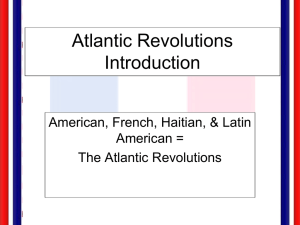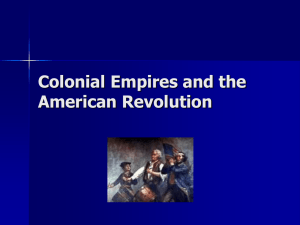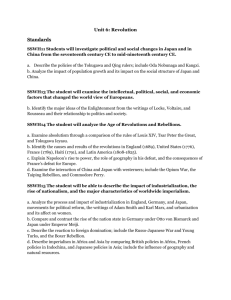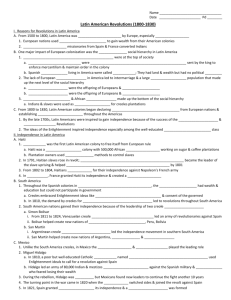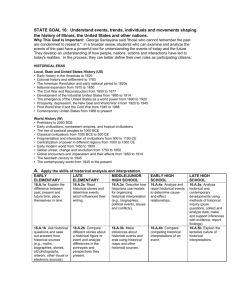World History 2 Focus Questions
advertisement
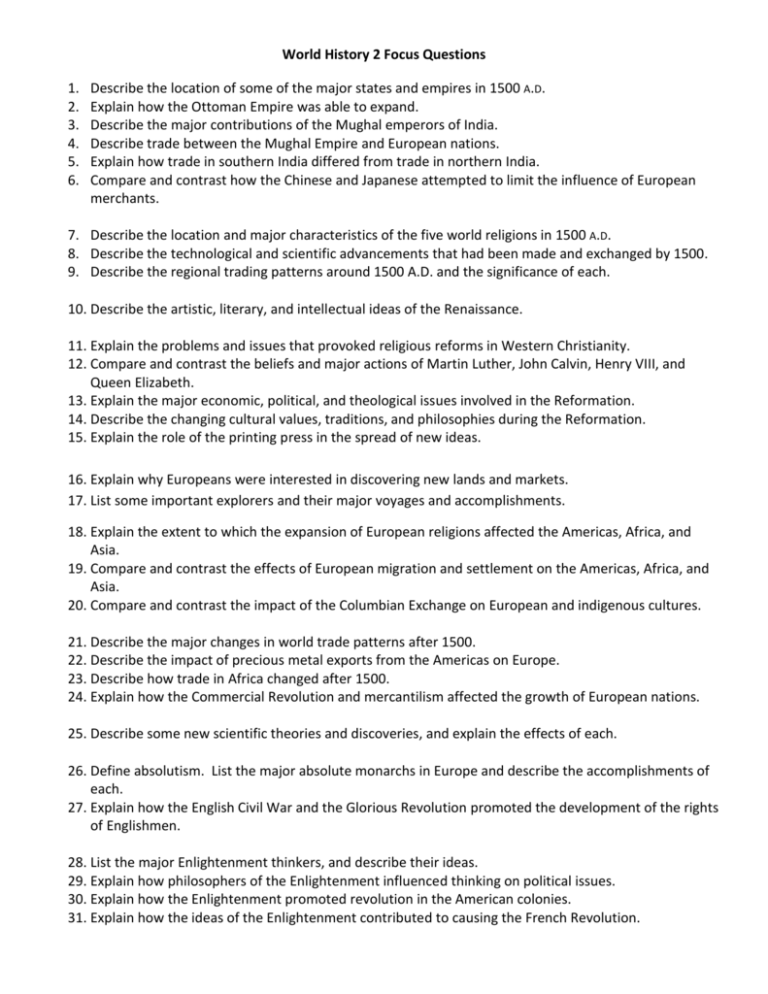
World History 2 Focus Questions 1. 2. 3. 4. 5. 6. Describe the location of some of the major states and empires in 1500 A.D. Explain how the Ottoman Empire was able to expand. Describe the major contributions of the Mughal emperors of India. Describe trade between the Mughal Empire and European nations. Explain how trade in southern India differed from trade in northern India. Compare and contrast how the Chinese and Japanese attempted to limit the influence of European merchants. 7. Describe the location and major characteristics of the five world religions in 1500 A.D. 8. Describe the technological and scientific advancements that had been made and exchanged by 1500. 9. Describe the regional trading patterns around 1500 A.D. and the significance of each. 10. Describe the artistic, literary, and intellectual ideas of the Renaissance. 11. Explain the problems and issues that provoked religious reforms in Western Christianity. 12. Compare and contrast the beliefs and major actions of Martin Luther, John Calvin, Henry VIII, and Queen Elizabeth. 13. Explain the major economic, political, and theological issues involved in the Reformation. 14. Describe the changing cultural values, traditions, and philosophies during the Reformation. 15. Explain the role of the printing press in the spread of new ideas. 16. Explain why Europeans were interested in discovering new lands and markets. 17. List some important explorers and their major voyages and accomplishments. 18. Explain the extent to which the expansion of European religions affected the Americas, Africa, and Asia. 19. Compare and contrast the effects of European migration and settlement on the Americas, Africa, and Asia. 20. Compare and contrast the impact of the Columbian Exchange on European and indigenous cultures. 21. Describe the major changes in world trade patterns after 1500. 22. Describe the impact of precious metal exports from the Americas on Europe. 23. Describe how trade in Africa changed after 1500. 24. Explain how the Commercial Revolution and mercantilism affected the growth of European nations. 25. Describe some new scientific theories and discoveries, and explain the effects of each. 26. Define absolutism. List the major absolute monarchs in Europe and describe the accomplishments of each. 27. Explain how the English Civil War and the Glorious Revolution promoted the development of the rights of Englishmen. 28. List the major Enlightenment thinkers, and describe their ideas. 29. Explain how philosophers of the Enlightenment influenced thinking on political issues. 30. Explain how the Enlightenment promoted revolution in the American colonies. 31. Explain how the ideas of the Enlightenment contributed to causing the French Revolution. 32. Explain how the French and American Revolutions influenced Latin America. 33. Describe the characteristics of the colonial system in Latin America in the Nineteenth century. 34. Explain how Spain and Portugal maintained control of their Latin American domains. 35. Explain how the French and American Revolutions influenced Latin American independence movements. 36. Compare and contrast the contributions of Toussaint L’Ouverture and Simon Bolivar to the revolutions in Latin America. 37. Explain how the Monroe Doctrine impacted revolutions in Latin America? 38. List some of the major artists, philosophers, and writers of the period and describe their major accomplishments. 39. Describe the major technologies and institutions that were important to European economies. 40. Describe the legacy of Napoleon. 41. Explain the significance of the Congress of Vienna. 42. Explain how nationalism and democracy influenced national revolutions. 43. Describe the events that led to the unification of Italy. 44. Explain the role of Otto von Bismarck in the unification of Germany. 45. Explain why the Industrial Revolution originated in England. 46. How did the Industrial Revolution produce changes in culture and society? 47. What was the role of capitalism and market competition in the Industrial Revolution? 48. Describe some theories opposed to capitalism. 49. How did the Industrial Revolution impact the lives of women, children, and the family? 50. How did the Industrial Revolution affect slavery? 51. Why did workers organize into labor unions? 52. Why did the spread of industrialism to Europe and the United States accelerate colonialism and imperialism? 53. Why did European countries participate in imperialism and a race for colonies? 54. Describe some of the different responses of colonized peoples to European imperialism. 55. Describe the major causes of World War I. 56. Describe the major events of World War I. 57. List the major leaders of World War I and discuss their contributions to the war. 58. Explain the outcomes and global effects of World War I. 59. Describe the terms of the Treaty of Versailles and how it led to World War II. 60. Why did Russia erupt in revolution while fighting in World War I? 61. Describe the rise of communism in Russia. 62. What was the League of Nations and why did it fail? 63. What was the mandate system and why was it created? 64. Explain the causes of global depression in the 1930s. 65. What political changes resulted from the worldwide depression of the 1930s? 66. Explain why dictatorial governments emerged in Germany, Italy, Japan, and the U.S.S.R. after World War I. 67. How did these regimes affect the world following World War I? 68. Explain the causes of World War II. 69. Describe the major events of World War II. 70. List the major leaders of World War II and discuss their major contributions to the war. 71. What was the holocaust and why did it occur? 72. Describe other examples of genocide in the twentieth century. 73. Describe the outcomes of World War II. 74. Describe the war crimes trials. 75. How did the Allies promote reconstruction of the defeated powers? 76. Describe some of the international cooperative organizations created after World War II. 77. Explain the events that led to the Cold War. 78. Describe the impact of nuclear weapons. 79. What were the causes and consequences of the collapse of the Soviet Union? 80. How did the Cold War influence conflicts in Eastern Asia after World War II? 81. Explain the policy of containment. 82. What role did Indira Gandhi, Margaret Thatcher, Mikhail Gorbachev and Deng Xiaoping play in the major events of the second half of the twentieth century? 83. Who was a leader of the Indian independence movement, and what tactics did he use? 84. What were the outcomes of the Indian independence movement? 85. What were the results of the United Nations’ decision to end the mandate system in terms of states created (locations) and their subsequent problems? 86. What was the role of Golda Meir and Gamal Abdul Nasser in the creation of states in the Middle East? 87. Why did independence movements in Africa gain success after World War II? 88. Describe Kenyatta’s leadership role in Kenya. 89. Compare and contrast violent and nonviolent independence movements in Africa. 90. Where are the followers of the five world religions concentrated? How and why did these locations change since 1500? 91. What are some characteristics of the five major world religions? 92. What are some challenges faced by the contemporary world? 93. What new technologies have created opportunities and challenges? 94. Define developed and developing nations, and explain the inequities in the social, cultural, and economic systems of both. 95. Compare and contrast the developing world and the developed world in terms of economic, social, and population characteristics. 96. What impact are economic development and rapid population growth having on the environment? 97. Explain the links between economic development and political freedom. 98. How is economic interdependence changing the world? 99. Define terrorism, and explain the causes and effects of terrorism in the contemporary world.

